The University of
Michigan Museum of Zoology
Periodical Cicada Page

[What is a periodical cicada?] [Are periodical cicadas
harmful?] [Magicicada life cycles] [Magicicada
broods (distribution maps)] [Magicicada behavior] [Magicicada species (with sound samples)] [Magicicada
diseases and deformities] [Magicicada bibliography] [Other cicada links] [To contact us]
ANNOUNCEMENT: 13-year periodical cicadas of Brood XIX are emerging across a large area of the eastern USA this spring. Exact locality records of these emergences are being sought from the public at www.magicicada.org
Periodical cicada FAQ
with quick answers to some common questions.
Cicadas are flying, plant-sucking insects of the Order Hemiptera; their
closest relatives are leafhoppers, treehoppers, and fulgoroids. Adult cicadas
tend to be large (most are 25-50mm), with prominent wide-set eyes, short
antennae, and clear wings held roof-like over the abdomen. Cicadas are probably
best known for their conspicuous acoustic signals or "songs", which
the males make using special structures called tymbals, found on the abdomen. There may be as many as 3000 different cicada species worldwide.
All but a few cicada species have
multiple-year life cycles, most commonly 2-8 years (de Boer and Duffels 1996).
In most cicada species, adults can be found every year because the population
is not developmentally synchronized; these are often called "annual" cicada species. In contrast, populations of the periodical
cicada species are synchronized, so
that almost all of them mature into adults in the same year. The fact that
periodical cicadas remain locked together in time is made even more amazing by
their extremely long life-cycles of 13 or 17 years.
Periodical cicadas are found in eastern North
America and belong to the genus Magicicada. There are seven species -- four with 13-year life cycles (including
one new species described in 2000), and three with 17-year cycles. The three
17-year species are generally northern in distribution, while the 13-year
species are generally southern and midwestern. Magicicada are so well-synchronized developmentally that they
are nearly absent as adults in the 12 or 16 years between emergences. When they
do emerge after their long juvenile periods, they do so in huge numbers,
forming much denser aggregations than those usually achieved by cicadas. Many
people know periodical cicadas by the name "17-year locusts" or
"13-year locusts", but they are not true locusts, which are a type of
grasshopper.
Magicicada adults have black bodies and striking red eyes and
orange wing veins, with a black "W" near the tips of the forewings.
Most emerge in May and June. Some of the annual cicada species are sometimes
mistaken for the periodical cicadas, especially those in the genera Diceroprocta and Okanagana; these other species emerge somewhat later in the year but may overlap
with Magicicada. The Okanagana species are the most potentially confusing because of
their similar black-and-orange coloration. The best way to identify cicada
species is by the sounds that they make,
because cicada songs are nearly always species-specific. Recordings of
periodical cicadas can be found below. To learn about some of the common annual
cicada species of eastern North America (including the genera Tibicen,
Diceroprocta, and Okanagana), and to
hear their songs, see our Michigan Cicadas
Page. Also check out the list of related links at the end of this page.
Female periodical cicadas (see picture below)
have a pointed abdomen with an ovipositor for laying eggs. The ovipositor is
sheathed and not clearly visible in these photographs.
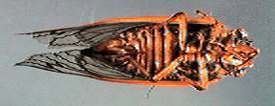

Males (below) have a blunter abdomen and
white, ribbed tymbals located on the sides of the first abdominal segment, just
behind the point of attachment of the hindwings. The lowest photo shows a male M.
septendecim with wings removed to
show the tymbal.
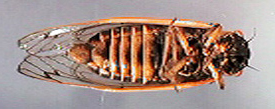


Are
periodical cicadas harmful?
Cicadas are harmless. They do not bite or
sting defensively, nor do they attack people. If a cicada lands on you, it is
only because it finds you to be a convenient place to land -- unless you happen
to be using a lawnmower or weed-whacker, in which case it might be attracted by
the sound! Basically, periodical cicadas can hurt you only if they mistake you
for a tree branch and try to feed, something that can happen only if you hold a
cicada in your hand for a very
long time (eventually this makes the cicada hot and thirsty). Such rare
mistakes feel like a brief pinprick and cause no damage. When handled, both
males and females struggle to fly at first, and males make a loud defensive
buzzing sound that may startle but is otherwise harmless. Periodical cicadas
are not poisonous to animals or humans, nor are they known to transmit disease.
Periodical cicadas can cause physical damage
to small trees or shrubs if too many feed from the plant or lay eggs in the
twigs; such damage can cause "flagging", or breaking of peripheral
twigs. Orchard and nursery owners probably should not plant young trees or
shrubs in the years preceding an emergence of periodical cicadas, because young
trees may be harmed by severe flagging. Mature trees and shrubs, however,
usually survive even dense emergences of cicadas without apparent distress.
This can be difficult to believe in the month or so following a large emergence
when many deciduous trees turn brown due to the breakage and death of
peripheral twigs. As serious as it may appear, such damage is apparently minor.
The simplest way to protect small trees and shrubs from damage is to physically
prevent cicadas from feeding and (especially) ovipositing by covering the
plants with screening material like cheesecloth; such screening should be
applied soon after the cicadas emerge and left in place until most cicdas have
died off (about four weeks). Periodical cicadas are often too numerous to make
application of pesticides practical.
Beyond the concern by owners of fruit
orchards and nurseries, periodical cicadas are not regarded as pests, except
maybe by those who tire of the din of their choruses.
Cicada juveniles are called
"nymphs" and live underground, sucking root fluids for food.
Periodical cicadas spend five juvenile stages in their underground burrows,
with each stage ending with eclosion (shedding of the old nymphal skin). Their burrows
are found anywhere from several inches to a few feet underground, depending on
nymphal age and the nature of the soil.
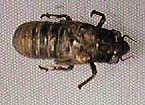
In the spring of their 13th or 17th year, a
few weeks before emerging, the nymphs construct exit tunnels to the surface.
These exits are visible as approximately 1/2 inch diameter holes, or as
chimney-like mud "turrets" the nymphs sometimes construct over their
holes. On the night of emergence, nymphs leave their burrows around sunset,
locate a suitable spot on nearby vegetation, and complete their final molt to
adulthood. Shortly after ecdysis (molting) the new adults appear mostly white,
but they darken quickly as the exoskeleton hardens. Sometimes a large
proportion of the population emerges in one night. Newly-emerged cicadas work
their way up into the trees and spend roughly four to six days as
"teneral" adults before they harden completely (possibly longer in
cool weather); they do not begin adult behavior until this period of maturation
is complete.
It appears that the particular night of
emergence may be determined by the soil temperature; nymphs emerge when the
soil temperature inside the exit tunnel (and therefore the body temperature of
the nymph) exceeds approximately 64 degrees F (Heath 1968). Because emergence
is temperature- dependent, periodical cicadas tend to emerge earlier in
southern and lower-elevation locations. For example, periodical cicadas in
South Carolina often begin to emerge in late April, while those in southern
Michigan do not appear until June. The best way to predict the time of
emergence for your area is to check records from the prior emergence in that
location, by asking longtime residents or by searching local newspaper
archives. The date of emergence does not vary much between generations,
although unusual springtime weather conditions may accelerate or delay the
emergence by a week or so.
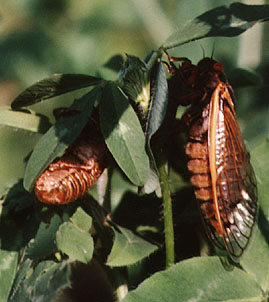
After their short teneral period, males begin
producing species-specific calling songs and form aggregations (choruses) that
are sexually attractive to females. Males in these choruses alternate bouts of
singing with short flights until they locate receptive females (see the Magicicada
behavior section below). Contrary to popular belief, adults do feed
-- by sucking plant fluids; adult cicadas will die within days if not provided
with living woody vegetation on which to feed. Magicicada feed from a wide variety of deciduous plants and
shrubs, but usually not from grasses. The picture below shows Magicicada
septendecula feeding, with the
piercing-and-sucking mouthparts visible just behind the forelegs.
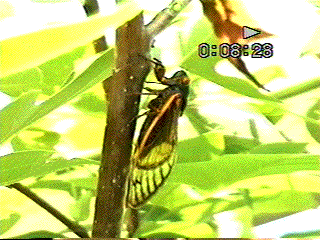
Mated females excavate aseries of Y-shaped
eggnests in living twigs and lay up to twenty eggs in each nest (Marlatt 1923).
A female may lay as many as 600 eggs (Marlatt 1923). Below is a photograph of Magicicada
eggnests.
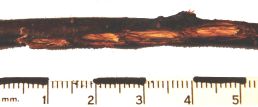
The adult emergence lasts for about four to six weeks after
the appearance of the first nymphs. Six to ten weeks or so after oviposition, in midsummer, the eggs
hatch and the new first-instar nymphs drop from the trees, burrow underground,
locate a suitable rootlet for feeding, and begin their long 13- or 17-year
development.
Why are there so many of them?
Periodical cicadas achieve astounding
population densities, as high as 1.5 million per acre (Dybas 1969). Densities
of tens to hundreds of thousands per acre are more common, but even this is far
beyond the natural abundance of most other cicada species. Apparently because
of their long life cycles and synchronous emergences, periodical cicadas escape
natural population control by predators, even though everything from birds to
spiders to snakes to dogs eat them opportunistically when they do appear. Magicicada population densities are so high that predators apparently
eat their fill without significantly reducing the population (a phenomenon
called "predator satiation"), and the predator populations cannot
build up in response because the cicadas are available as food above ground
only once every 13 or 17 years. Periodical cicadas do have a specialized fungal
parasite (see the Magicicada diseases and deformities section), but
its effects on Magicicada
population density are not well understood. Individual periodical cicadas are
slower, less flighty, and easier to capture than other cicadas, probably
because the safety afforded by their great numbers means that the risks of
predation for an individual are low. Explaining the evolution of such an
unusual life strategy is one of the most difficult problems for periodical
cicada biologists.
Magicicada broods and distributions
ANNOUNCEMENT: 13-year periodical cicadas of Brood XIX are emerging across a large area of the eastern USA this spring. Exact locality records of these emergences are being sought from the public at www.magicicada.org
Although nearly all of the periodical cicadas
in a given location emerge in the same year, the cicadas in different regions
are not synchronized and may emerge in different years. All periodical cicadas
of the same life cycle type that emerge in a given year are known collectively
as a single "brood" (or "year-class"). The resulting broods
are designated by Roman numerals -- there are 12 broods of 17-year cicadas
(with the remaining five year-classes apparently containing no cicadas), and 3
broods of 13-year cicadas (with ten empty year-classes). As a result, it is
possible to find adult periodical cicadas in almost any year by traveling to
the appropriate location. The table below is a guide to the approximate locations of periodical cicada broods. On a local
scale, periodical cicadas can be very patchily distributed.
Click here for a small-scale composite map of all brood ranges.
Click on a brood number in the table below to
see a larger-scale map of that brood's range.
|
17-year Broods |
Year |
|
|
|
General region |
|
1961 |
1978 |
1995 |
2012 |
VA, WV |
|
|
1962 |
1979 |
1996 |
2013 |
CT, MD, NC, NJ, NY, PA, VA |
|
|
1963 |
1980 |
1997 |
2014 |
IA, IL, MO |
|
|
1964 |
1981 |
1998 |
2015 |
IA, KS, MO, NE, OK, TX |
|
|
1965 |
1982 |
1999 |
2016 |
MD, OH, PA, VA, WV |
|
|
1966 |
1983 |
2000 |
2017 |
GA, NC, SC |
|
|
1967 |
1984 |
2001 |
2018 |
NY |
|
|
1968 |
1985 |
2002 |
2019 |
OH, PA, WV |
|
|
1952 |
1969 |
1986 |
2003 |
NC, VA, WV |
|
|
1953 |
1970 |
1987 |
2004 |
DE, GA, IL, IN, KY, MD, MI, NC, NJ, NY, OH, PA, TN, VA, WV |
|
|
1956 |
1973 |
1990 |
2007 |
IA, IL, IN, MI, WI |
|
|
1957 |
1974 |
1991 |
2008 |
KY, GA, IN, MA, MD, NC, NJ, NY, OH, PA, TN, VA, WV |
|
|
13-year Broods |
|
|
|
|
|
|
1972 |
1985 |
1998 |
2011 |
AL, AR, GA, IN, IL, KY, LA, MD, MO, MS, NC, OK, SC, TN, TX, VA |
|
|
1975 |
1988 |
2001 |
2014 |
LA, MS |
|
|
1976 |
1989 |
2002 |
2015 |
AR, IL, IN, KY, LA, MO, MS, TN |
Note: Maps are based on a variety
of published and unpublished sources, and are intended to give only approximate
brood ranges. Consult published sources (e.g., Simon 1988, Marlatt 1923 or USDA
reports) for more detailed information.
Sometimes periodical cicadas emerge
"off-schedule" by one or more years. This phenomenon is called
"straggling," although straggling cicadas can emerge either later or
earlier than expected. The most common form of straggling is one-year premature
or delayed emergences, usually involving small numbers of cicadas.
Unexpectedly, the next most common form of off-schedule emergence is four-year premature appearances by 17-year cicadas, and these
events sometimes involve many thousands at once. In 2000, many cicadas emerged
four-years early across the range of Brood X. A similar event was observed in
1969 in the Chicago area, four years before the normal emergence in 1973 (Dybas
1969). These events help us to understand the origin of the various same-cycle
broods as well as the developmental mechanisms underlying Magicicada speciation, which tends to involve permanent shifts
between life cycle types (see details on the seven species and their
relationships below). Straggling makes it difficult to construct accurate maps
of periodical cicada brood distributions (Marshall 2001), partly because
historical reports of off-schedule emergences often contain little or no
information about how many cicadas were seen.
As in nearly all cicada species, male
periodical cicadas produce "songs" using a pair of tymbals, or ridged
membranes, found on the first abdominal segment. The abdomen of a male cicada
is hollow and may act as a resonating chamber; the songs of individuals are
loud, and large choruses can be virtually deafening. Females of most cicada
species do not have sound-producing organs. Both sexes hear the sounds of the
males as well as other sounds using membranous hearing organs called
"tympana" found on the underside of the abdomen.
Over the course of an emergence, males
congregate in "choruses" or singing aggregations, usually in high,
sunlit branches. Females visit these aggregations and mate there, so choruses
contain large numbers of both sexes.
Males of all Magicicada species (each described individually below in the Magicicada
species section) produce alarm calls when handled, calling songs
that attract males and females to the chorus, and one or more courtship calls
when approaching and attempting to mate with females. Five different male
acoustic signals have been described for the -decim and -cassini cognate species. Samples of most of these sounds are included below.
These species have calling and courting signals that differ in pitch
(frequency) and other characteristics, but the signals have have similar
structures, so they can be described together. The functions of these signals
are not entirely understood, but they have been given names to indicate their
suspected function. The acoustical behaviors of the -decula species have not been as well characterized.
Female Magicicada produce timed "wing flick" signals in
response to male calls, and the timing of this signal in relation to the male
call is species-specific for species of the same life cycle. The signal
consists of a quick flip of the wings that creates a broad-frequency sound that
can vary from a soft rustle to a sharp snap. Males are able perceive both the
visual and acoustic components of the wing-flick.
A chorusing male perceiving a female signal
increases his number of calls relative to movement distance, increasing the
odds that he will elicit further responses from any nearby female. If the male
receives multiple responses, he ceases sing-fly behavior, begins CI courtship,
and engages in a signaling duet with the wing flicking female, evidently for
the purpose of locating her. Between calls, duetting males often walk towards
the signaling female, and while approaching, begin CII calling. After contacting
the female or while preparing to mount, the male begins CIII calling, which he
continues until he mounts and copulates. Under some circumstances, males
engaged in duets acoustically obscure the downslurs of potential competitors,
reducing the likelihood of a female response and increasing the likelihood that
competing males will continue chorusing, depart and search elsewhere. Although
female wing-flick signaling is known in some Australian and New Zealand cicadas
(e.g., Lane 1995), this is the first reported incidence of female signaling in
North American cicadas. For more detail about female signals in Magicicada, see Cooley and Marshall (2001).
Male signals: (for recordings see the Magicicada
species section)
Alarm
Call: A coarse buzz that males make
when startled or handled; it is roughly similar in pitch to the calling song.
Calling
song: Attracts both males and females
to the chorus. Male -decim
alternate bouts of calling (usually 1-3 calls) with short flights, while -cassini and -decula
may make just one call between flights. The calls are approximately 1.5 - 3
seconds long in -decim and -cassini, and they are separated by silent gaps of about 1-2
seconds. The calling song of -decula
is much longer, roughly 10-15 seconds in duration.
Court
I (CI) Call: This signal is
constructed of a series of phrases very similar to those used in the calling
song, but more often without intervening bouts of flying or walking, and often
with the gaps shortened. Males produce CI, CII, and CIII calls when courting a
nearby female.
Court
II (CII) Call: For -decim and -cassini, the phrases of this call are similar to those in CI calls. However,
there are no gaps between call phrases, and the phrases may be shortened, or
include an upslur. Males usually produce the CII call shortly before attempting
to mount a female. The Court II call in -decula, if it exists as in the other two species, has not
been well-characterized.
Court
III (CIII) Call: This call consists
of a continuous series of short, staccato buzzes, about 4-6 per second, in all
three species. Males produce this signal while attempting to mount the female,
stopping the sound only after engaging their genitalia.
Female signals:
Female wing flick signal: Females produce timed "wing flick" signals
in response to male calls. The timing of this signal in relation to the male
call is species-specific.
|
M. -decim (51K) |
|||
|
M. -cassini (97K) |
|||
|
M. -decula (41K) |

Magicicada
species
Three17-year cicada species exist, each with
distinctive morphology (shape and color), behavior, and calling signals. They
are named below:
Magicicada septendecula (Alexander and Moore)
For each 17-year species, there is at least
one morphologically and behaviorally similar species with a 13-year life cycle;
these four 13-year species are listed below. M. neotredecim was discovered only recently, so it is not mentioned
in most publications on periodical cicadas.
Magicicada tredecim (Walsh and Riley) - approximately similar to M. septendecim
Magicicada neotredecim (Marshall and Cooley) - extremely similar to M.
septendecim
Magicicada
tredecassini (Alexander and
Moore) - extremely similar to M. cassini
Magicicada
tredecula (Alexander and
Moore) - extremely similar to M. septendecula
The closest relative of each Magicicada species appears to be a counterpart with the
alternative life cycle, from which it can be distinguished only by life cycle
and geographic distribution. Some biologists have argued that the life cycle
difference alone is not enough to justify species status. More information on
the nature of the boundary between 13- and 17-year populations and the extent
of hybridization between them would help to resolve this question, but for now
there is no evidence that the distinctiveness of the life-cycle forms is decreasing.
For this reason and for practical purposes, most writers have adopted the
taxonomy that recognizes the life cycle siblings as distinct species.
Most of the broods contain all of the 13- or
17-year species, with a few exceptions. Brood VII contains only M.
septendecim (which tends to be found
alone along the northern edge of the 17-year range), and 13-year Brood XXII
lacks the new species M. neotredecim.
Also, the four 13-year species are all found together in only a limited portion
of the 13-year range (see below for more on this and the range of M.
neotredecim).
The songs and morphology of the three 17-year
species are described in detail below, as are the songs and morphology of the
13-year -decim species (M. neotredecim and M. tredecim). For
practical purposes, the data provided for M. cassini and M. septendecula can be used to identify their 13-year counterparts.
The photographs below show, from left to right, dorsal and ventral views of a
male, and dorsal and ventral views of a female. Each specimen is pinned through
the thorax. The scale is a centimeter scale.
The largest of the periodical cicadas, with
broad orange stripes on the underside of the abdomen, and with orange
coloration on the sides of the thorax behind each eye and in front of the
forewings (not visible in the photographs below, but partly visible in the M.
septendecim tymbal photo above in the
What is a periodical cicada?
section). The calling song phrases are said to resemble the word
"Pharaoh". Scale below is 1 cm long.
Magicicada septendecim songs:
|
Chorus |
|||
|
Calling song / Court I (complete phrases) |
|||
|
Court II (fragment) |
|||
|
Court III (fragment) |
Usually smaller than M. septendecim. No orange coloration in front of the wing insertion
behind the eye. Abdomen entirely black except in some locations where
individuals may have weak ventral yellow-orange marks; if present, these tend
to be faded and rarely form complete stripes. Sometimes such individuals may be
difficult to distinguish from M. septendecula if the calling song is not available. Calling song
phrases consist of a series of ticks followed by a shrill buzz. Males of M.
cassini and its close 13-year
relative M. tredecassini sometimes
synchronize their calls and flights all at once, a display that has been
likened to a "giant game of musical chairs". Scale below is 1 cm
long.
Magicicada cassini songs:
|
Chorus (septendecim in background) |
|||
|
Calling song / Court I (complete phrases) |
|||
|
Court II (fragment) |
|||
|
Court III (fragment) |
Usually smaller than M. septendecim and similar to M. cassini in size, with narrow, well-defined orange stripes on
the underside of the abdomen but no orange coloration in front of the wing
insertion behind the eye. This species is often much more rare than M.
septendecim and M. cassini. The calling song of the -decula sibling species is rhythmically unlike those of the
other two forms, and consists of a series of short phrases lasting 15-30
seconds. The first two courtship songs have not been well characterized, but
may bear the same relationship to each other as the courtship songs of the
other species. Scale below is 1 cm long.
Magicicada septendecula songs:
|
Chorus (mixed with cassini) |
|||
|
Calling song (complete song) |
|||
|
Variant of calling song? (complete song) |
|
||
|
Court III (fragment) |
Generally similar to M. septendecim and M. neotredecim in appearance and behavior, but with lower pitched
songs and lacking dark bands on underside of abdomen. Underside of abdomen
varies from light orange to caramel color; sometimes light color extends up
sides of abdomen above spiracles.
Magicicada tredecim songs:
|
Calling song / Court I (complete phrases) |
||
|
Court II (fragment) |
||
|
Court III (fragment) |
NEW SPECIES -- Magicicada
neotredecim
M. neotredecim was described in 2000 (see Evolution Vol. 54, No.4,
Pp. 1313-1325). M. neotredecim and
its closest relative, M. septendecim,
are consistently distinguishable only in life cycle length. The new species is
similar to 13-year M. tredecim,
but distinguishable in male song pitch, female song pitch preferences (Marshall
and Cooley 2000), abdomen color, and mitochondrial DNA (mtDNA) lineage (Simon
et al. 1998, Martin and Simon 1988, 1990). These findings are consistent with
the theory that M. neotredecim
evolved from populations of M. septendecim by a life cycle change (Martin and Simon 1988, 1990, Marshall and
Cooley, 2000, Simon et al. 2000).
The two 13-year -decim species have a special
geographic relationship -- they are not sympatric (living together) across the
entire 13-year range. M. neotredecim
inhabits the midwestern part of the 13-year range, while M. tredecim inhabits the southern and southeastern part. The two
species overlap only along a narrow region in northern Arkansas, western
Kentucky, and southern Missouri, Illinois, and Indiana. (For a map of these
species' distributions in Brood XIX click here.) By comparison, the three 17-year species are found
together from Connecticut to Kansas, and the remaining 13-year species together
inhabit most 13-year populations. Where M. neotredecim and M. tredecim overlap, male calling songs (and female song preferences) of these
species have evolved to become more distinct. In this overlap zone, M.
neotredecim songs are much
higher-pitched, while M. tredecim
songs are slightly lower-pitched. This suggests that the songs have evolved to
reduce wasteful sexual interactions between the species.
For a sonogram illustrating M. neotredecim and M. tredecim calling song pitch differences where they overlap geographically,
click here
The photos below show that M. neotredecim is extremely similar to 17-year M. septendecim in appearance. The dark bands on the underside of the
abdomen are similar to those of M. septendecim. Again, the calling song of M. neotredecim is very high-pitched only where it overlaps M.
tredecim geographically; the sample
below is taken from this overlap zone. Outside of that region, M.
neotredecim songs sound like those of
M. septendecim.
Magicicada neotredecim songs:
|
Calling song / Court I (complete phrases: high-pitch song from overlap
zone) |
||
|
Court II (fragment) |
||
|
Court III (fragment) |
Magicicada diseases and deformities
Magicicada do not have any specialized predators, but periodical
cicadas are subject to infection by the specialized fungal parasite Massospora
cicadina Peck. During an emergence of
periodical cicadas, both sexual and asexual forms of the fungus are present.
Cicadas infected early in the emergence develop asexual spores, which become
evident as the rear of the infected individual's abdomen breaks off, exposing a
white, chalky mass of spores. This infection sterilizes the cicada but does not
kill it immediately. These spores spread among the population, infecting other
cicadas who will develop a secondary infection and whose abdomens will later
break open, releasing sexual resting spores to infect the next generation of
cicadas.

Cicadas sometimes fail to properly inflate
their wings after molting; such individuals can be found in low vegetation in
any emergence. There may be a tendency for this to occur more often when the
cicadas are crowded and the emerging nymphs have difficulty finding good places
to perch for eclosion. The cicadas in the picture below came from a 1990
emergence in a suburban front yard near Chicago. Many of the cicadas in this
area had deformed wings.
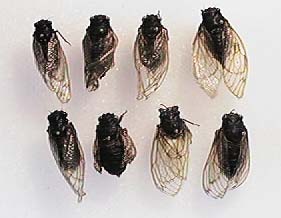
Molting can go wrong in other ways too. The
cicadas in the picture below all failed to emerge completely from their nymphal
skins. They died partially emerged.
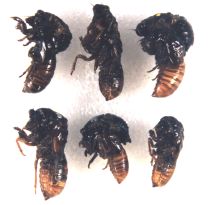
Cooley, J. R., and D. C. Marshall. 2001.
Sexual signaling in periodical cicadas, Magicicada spp. (Hemiptera: Cicadidae). Behaviour 138: 827-855.
de Boer, A.J., and J. P. Duffels. 1996.
Historical biogeography of the cicadas of Wallacea, New Guinea and the West
Pacific: a geotectonic explanation. Paleogeography, Palaeoclimatology,
Palaeoecology 124: 153-177.
Dybas, H. S. 1969. The 17-year cicada: a
four-year "mistake"? Bull. Field Mus. Nat. Hist. 40: 10-12.
Heath, J. E. 1968. Thermal synchronization of
emergence in periodical "17-year" cicadas (Homoptera: Cicadidae:
Magicicada). Am. Midl. Nat. 80: 440-447.
Lane, D. H. 1995. The recognition concept of
species applied in an analysis of putative hybridization in New Zealand cicadas
of the genus Kikihia (Insecta: Hemiptera: Tibicinidae). In: M. Lambert and H.
G. Spencer, eds. Speciation and the recognition concept: Theory and
Application. (The Johns Hopkins University Press, Baltimore and
London).Marlatt, C. L. 1923. The periodical cicada. U.S.D.A. Bur. Entomol.
Bull. 71: 1-183.
Marshall, D. C. 2001. Periodical cicada
life-cycle variations, the historical emergence record, and the geographic
stability of brood distributions. Annals of the Entomological Society of
America. 94: 386-399.
Marshall, D. C. and J. R. Cooley. 2000.
Reproductive character displacement and speciation in periodical cicadas, with
description of a new species, 13-year Magicicada neotredecim. Evolution 54:
1313-1325.
Martin, A., and C. Simon. 1988. Anomalous
distribution of nuclear and mitochondrial DNA markers in periodical cicadas.
Nature 336: 237-239.
Martin, A., and C. Simon. 1990. Differing
levels of among-population divergence in the mitochondrial DNA of periodical
cicadas related to historical biogeography. Evolution 44: 1066-1080.
Simon, C. 1988. Evolution of 13- and 17-year
periodical cicadas (Homoptera: Cicadidae). Bull. Entomol. Soc. Am. 34: 163-176.
Simon, C., J. Tang, S. Dalwadi, G. Staley, J.
Deniega, T. Unnasch. 2000. Genetic evidence for assortative mating between
13-year cicadas and sympatric '17-year cicadas with 13-year life cycles
provides support for allochronic speciation. Evolution 54: 1326-1336.
Click here for a list of published scientific literature about periodical cicadas
(with emphasis on post-1960 references).
Click here for a list of published scientific literature about cicadas in general.
Web-based monitoring of periodical cicada brood distributions is ongoing at John Cooley's www.magicicada.org site.
Visit our UMMZ
Cicada page.
For song recordings of cicadas of the United States and Canada, go to the InsectSingers.com site. Content on
eastern cicadas is here, and some western cicada songs are here.
To learn about cicadas of New England, check
out the comprehensive Cicadas of Massachusetts page, constructed by Gerry Bunker.
To learn about other cicadas of the Mid-Atlantic region, check
out John Zyla's excellent Cicadas.info page.
Dan Century's Cicada Mania page is an excellent general cicada site with photo
galleries and numerous links to other cicada websites.
Chris Simon's Cicada
Central site at The University of
Connecticut is an extensive cicada resource including pages on Periodical
Cicadas, New Zealand Cicadas, and a web-searchable Magicicada specimen database. This site also
contains brood maps with distributions shown as county-level records.
Email:
David Marshall: pterophylla@yahoo.com
U. S. Postal Service:
John Cooley
Ecology & Evolutionary Biology
University of Connecticut
75 North Eagleville Road, U-3043
Storrs CT 06269
David Marshall
Ecology & Evolutionary Biology
University of Connecticut
75 North Eagleville Road, U-3043
Storrs CT 06269
All text, images, and sounds contained in or
referenced by this page copyright John Cooley, David Marshall, and Mark
O'Brien. No material from these pages may be
duplicated or reproduced in any form without the written permission of the
University of Michigan Museum of Zoology.
Last updated 6 May 2011
Keywords: periodical cicada, periodical
cicadas, Magicicada, septendecim, cassini, septendecula, tredecassini,
tredecula, tredecim, 17-year locust, 13-year locust, Homoptera, Cicadidae,
Harvestfly.